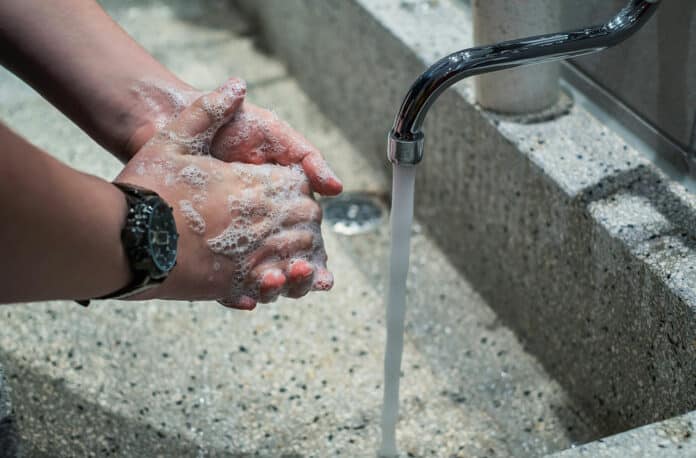COVID-19 has been a global public health crisis since its outbreak in late 2019. The disease is caused by the severe acute respiratory syndrome coronavirus 2 (SARS-CoV-2) and primarily spreads through respiratory droplets when an infected person talks, coughs, or sneezes. However, new research has highlighted the role of hands and surfaces in the spread of COVID-19 within households.
New research led by Imperial College London highlights the role of hands and surfaces in the spread of COVID-19 within households. It is the first to establish a link between the presence of SARS-CoV-2 on hands and surfaces and the risk of infection among contacts. The study underscores the importance of interventions at home, such as handwashing, regular surface disinfection, physical distancing, and mask-wearing, to prevent COVID-19 transmission.
A new study of 279 households in London, published in The Lancet Microbe, found that the presence of the SARS-CoV-2 virus on hands and frequently touched household surfaces is linked to the risk of infection among contacts. The research was conducted at the National Institute of Health and Care Research (NIHR) Health Protection Research Unit (HPRU) in Respiratory Infections, a partnership between Imperial College London and the UK Health Security Agency (UKHSA), during the alpha and pre-alpha waves of the pandemic.
Lead author Professor Ajit Lalvani emphasized the significance of the findings, stating that “the study provides the first evidence that the presence of the virus on hands or household surfaces predicts transmission to contacts.”
SARS-CoV-2 transmission mainly occurs in households, but the transmission routes remain an area of ongoing scientific debate. There is little empirical evidence for the pathways through which the virus spreads, which hampers accurate modeling of disease transmission and the development of evidence-based public health guidance. This study is the first to identify a correlation between SARS-CoV-2 RNA on candidate vectors and infection of contacts, providing empirical data on household transmission.
The study found that primary cases’ hands, household surfaces, and contacts’ hands strongly correlated with contacts’ risk of infection. The findings support interventions such as frequent handwashing, surface cleansing, physical distancing, reducing direct contact, and using masks to reduce household transmission.
Participants in two community-based observational studies in Greater London, UK (INSTINCT and ATACCC) were enrolled between August 2020 and March 2021. SARS-CoV-2 PCR-positive primary cases and their contacts were identified through the national contact tracing system and invited to participate. The INSTINCT study enrolled primary cases and their household contacts within five days of symptom onset and collected URT and surface/hand swabs at multiple time points.
The ATACCC study recruited household and non-household contacts to perform self-taken daily URT swabs for up to 28 days after enrolment, with additional sampling for those who consented to household visits. Sociodemographic, clinical, and epidemiological data were collected via questionnaires. Ethics approval was obtained from the Health Research Authority.
Participants were allowed to withdraw from the study or choose not to disclose certain sociodemographic information. The full household contacts cohort included all household contacts with ≥3 URT samples, while the serology subcohort consisted of unvaccinated contacts within the full cohort with longitudinal serology data. Covariates such as age, ethnicity, BMI, comorbidities, and vaccination status were considered. Relationship status to the primary case and household deprivation were also assessed. All participants provided written informed consent.
RT swabs and serology were analyzed using comparable methods at Imperial College London and UKHSA Colindale. Seropositivity was indicated by a DABA level of 1 or more. Variant status was assigned through S-gene target failure and whole-genome sequencing. Hand and surface swabs were tested for RNA presence, and PCR-positive samples were subjected to viral culture. Swabs were maintained at 4°C until the culture was performed. Further details can be found in the appendix.
The study aimed to identify risk factors for infection among household contacts, with the primary outcome defined as contacts becoming PCR-positive or infected in the serology subcohort. The household infection rate was calculated as the proportion of contacts who became PCR-positive or infected. Multivariable, modified Poisson regression analyses were performed to estimate adjusted relative risks, accounting for household clustering. The funder had no role in the study. Analyses were performed on R version 4.0.5.
620 confirmed cases of SARS-CoV-2 were examined in London between August 2020 and March 2021, of which 414 household contacts were included in the study. Participants with no URT samples at least three times, non-household contacts, and those with high Ct values between consecutive PCR-negative swabs were excluded. Of the 414 participants, 134 had longitudinal serology data and were included in the serology subcohort.
No significant differences were observed between the PCR-positive and PCR-negative contacts in the full household contacts’ cohort for sex, age, ethnicity, or BMI, except for men, who had a higher risk of infection in the serology subcohort. Comorbidities were less likely in participants who tested positive for PCR. The proportion of vaccinated individuals was higher in PCR-negative cases.
In conclusion, the new research by Imperial College London has highlighted the importance of hands and surfaces in the spread of COVID-19 within households. The study’s findings support the use of interventions at home, such as frequent handwashing, regular surface disinfection, physical distancing, and mask-wearing, to curb the spread of COVID-19. By implementing these measures, households can play a crucial role in breaking the chain of COVID-19 transmission and reducing the overall burden of the pandemic.
Journal Reference:
- Derqui-Parraga, N., et al. (2022). Risk factors and vectors for SARS-CoV-2 household transmission: a prospective, longitudinal cohort study. The Lancet Microbe, 3(3), e124-e133. DOI: 10.1016/S2666-5247(23)00069-1
